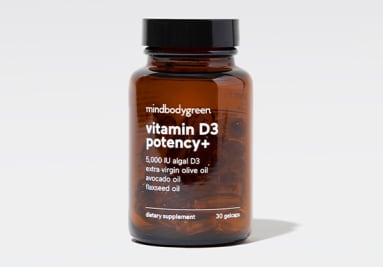
Image by Danil Nevsky / Stocksy
June 1, 2023
Our editors have independently chosen the products listed on this page. If you purchase something mentioned in this article, we may
While it’s best known for its mood and bone benefits, vitamin D affects diverse areas of whole-body health well beyond bone integrity and musculoskeletal function.*
Given its wide range of perks that span from gut and skin health to oral health, you’d think getting enough vitamin D would be at the top of everyone’s health priority list.*
Advertisement
This ad is displayed using third party content and we do not control its accessibility features.
And yet, approximately 93%1 to 100% of the U.S. population is failing to consume just 400 IU of vitamin D daily (which is way less than what’s actually needed). The thing is, it’s not entirely our fault.
Why we aren’t getting enough vitamin D
It’s ridiculously difficult (read: near impossible) to get enough vitamin D daily from diet and sunlight alone. There are a few reasons for this. Low vitamin D levels in foods is one, thanks to an almost 100-year-old vitamin D food fortification approach. Plus, while many assume they can get enough vitamin D from the sun, this method is severely limited by one’s location, season, skin tone, and levels of air pollution in their area.
The end result is that a whopping 41% of U.S. adults2 are estimated to be clinically insufficient in vitamin D [i.e., serum 25(OH)D levels greater than 20 ng/ml but less than 30 ng/ml], while another 29% are deficient in the essential vitamin (i.e., 20 ng/ml or lower)—and even those levels aren’t optimal for reaping the full health benefits vitamin D has to offer.
“[30 ng/ml] is the bare minimum level to avoid issues known to occur with vitamin D deficiency, including suboptimal bone and thyroid health,” explains board-certified endocrinologist Brittany Henderson, M.D., who specializes in hormones (including vitamin D) in her clinical practice. “Higher levels of serum 25(OH)D [the biomarker for vitamin D status] have consistently been associated with healthy mood, optimal immune function, and more.”*
It’s for this reason that Henderson (and many other leading functional medicine experts) aim for a vitamin D status of at least 50 ng/ml to promote whole-body health and longevity—but doing so is no easy feat.*
Advertisement
This ad is displayed using third party content and we do not control its accessibility features.
Reaching optimal vitamin D status
“The majority of the world is vitamin D deficient. As an endocrinologist, I know that achieving optimal serum 25(OH)D levels in the 50+ ng/ml range is imperative for immune health, bone health, and more,”* explains Henderson.
What’s more, Henderson shares that it’s actually underserving clients to stop at 30 ng/ml. “Our population is heavily vitamin D deficient, and targeting an optimal level of 50 ng/ml has an enormous impact on all aspects of human health,” she adds.
The most viable way to achieve or surpass that coveted 50 ng/ml status? A high-quality, effective vitamin D supplement. There’s just one catch: “It’s difficult for most standard vitamin D formulations to achieve this,” Henderson says, adding that it can take up to 10,000 IU of daily vitamin D3 (or more) to address cases of significant vitamin D deficiency (particularly when considering individualized factors like body composition or other variables).
Ultimately, achieving and maintaining vitamin D sufficiency day in and day out (i.e., for life) comes down to high-quality, bioavailable D3 supplementation—which is why Henderson personally loves mbg’s vitamin D3 potency+.
Why Henderson trusts mbg’s vitamin D3 potency+
“Vitamin D is fat-soluble and, thus, better absorbed when administered in a fatty packaging,”* Henderson explains. “So, we typically recommend forms of vitamin D3 that are more highly bioavailable, meaning that they are packaged along with oils or fats.”*
With 5,000 IU of organic, algal-sourced vitamin D3 and a trio of built-in organic oils (avocado, flaxseed, and extra-virgin olive) for enhanced bioavailability, our vitamin D supplement fits the bill and stands out from the crowd of other D options.
“mbg’s vitamin D3 potency+ delivers organic plant-derived vitamin D3 packaged in a fat-soluble envelope of oils. With this innovative technology, vitamin D3 potency+ can achieve optimal D3 levels and keep them there,”* Henderson shares.
Indeed, a premium daily D3 supplement is an effective solution to the nationwide dilemma (actually it’s a global problem3) that can’t be widely solved with sunshine and diet alone—but vitamin D supplements are created far from equal. “The formulation of vitamin D3 is the most important variable,” says Henderson. “It has to be packaged as highly bioavailable or it just won’t work!”
Advertisement
This ad is displayed using third party content and we do not control its accessibility features.
The takeaway
For a bioavailable D3 supplement that delivers an efficacious dose of vitamin D (i.e., 5,000 IU of algal-derived D3) with built-in absorption technology in just one daily gelcap, mbg’s vitamin D3 potency+ can’t be beat.*
And leading health experts agree! To see what Brittany Henderson, M.D., and others have to say about mbg’s vitamin D supplement, read their rave reviews here.
If you are pregnant, breastfeeding, or taking medications, consult with your doctor before starting a supplement routine. It is always optimal to consult with a health care provider when considering what supplements are right for you.


